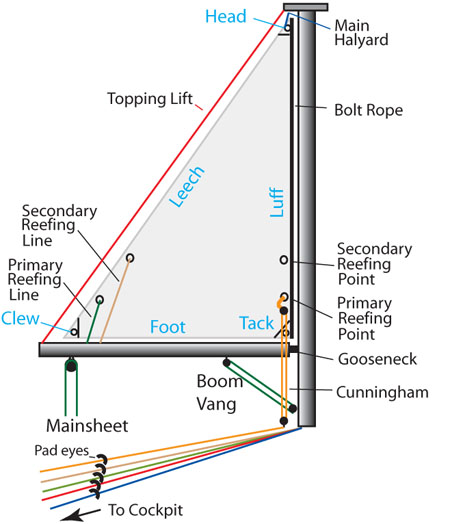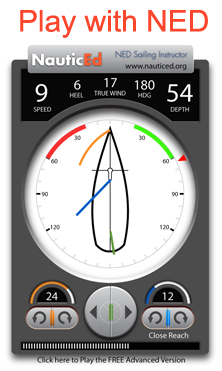This Learn to Sail article was written by NauticEd – the World’s Most Technologically Advanced Sailing School.
On a sailboat, there are 5 common sails that are used. The mainsail, the jib sail, the genoa, the spinnaker and the genaker.
In this learn to sail series article we’ll discuss the mainsail, how it is used and its approximate set for the wind angle.
The mainsail is literally “the main sail”. You can use the main sail at all points of sail from close haul (usually about 30-40 degrees off from where the wind is coming from) to a downwind run. It’s a big sail although some offshore sailboats and racing sailboats carry with them different size mains for different wind conditions. The largest mainsail on board is referred to as the number 1 mainsail.
So as you learn to sail, the main sail is the most common sail that you will be using. It’s typically a triangle shape angling down towards the stern of the boat from the top of the mast. Some mainsails have a “roach”. A roach is when the mainsail leech (trailing edge of the sail) has a curve to it. This makes the area aloft greater, giving the boat more power. Horizontal battens hold the sail shape, and are especially needed when the sail has a roach. Mainsails that roll up into the mast can not have horizontal battens however because they will not roll up. Some sailmakers have compensated by sewing in to the mainsail vertical battens. This allows the sail to be furled (rolled up) while maintaining the ability to give an airfoil shape to the sail.
With out going into the details in this article of how the wind drives the sails we’ll rather describe the sail set simplistically so that as you begin to learn to sail you can get the boat moving.
- When you’re heading on a close haul, 30-40 degrees away from the direction of origin of wind, you should have the mainsail set to about 10 degrees off the center line of the sailboat.
- On a close reach (50 – 70 degrees) set the mainsail about 40 degrees off the centerline of the sailboat.
- On a reach (80- 100 degrees) set the mainsail at about 60 degrees.
- On a broad reach (110 – 140 degrees) set the mainsail at about 70 degrees but also ensure that the mainsail is not resting too heavily on the spreader bars (cross bars mounted up on the mast).
- On a run (150 – 180 degrees) set the mainsail at about 85 degrees and as above ensure that the mainsail is not resting too heavily on the spreader bars (cross bars mounted up on the mast).
NauticEd has a really great learn to sail interactive tool to help people work with the sail angles according to the direction of the wind. It’s an online sailing Instructor called NED.
Visit NED at http://www.nauticed.org/sailing-instructor
The above is a really great learn to sail rule of thumb and will mostly keep you out of the confusion zone. In a follow on article we’ll give you the physics of it all but not now.
Another minor use of the mainsail worthy of note however is that it can prevent side to side roll of the sailboat when motoring through rolling seas. When motoring into the wind, just raise the mainsail and tighten up the mainsheet so that the boom does not swing. The air resistance from the sail prevents the rolling and gives a much more comfortable motoring experience.
So there you have it. You now know a little about the mainsail and a little about how to set it.
This learn to sail series is written by Grant Headifen, Educational Director of NauticEd. NauticEd is an online sailing school providing sailing education and sailing certifications to beginner through advanced sailors.
For more info see http://www.nauticed.org where you can learn to sail with the best.



